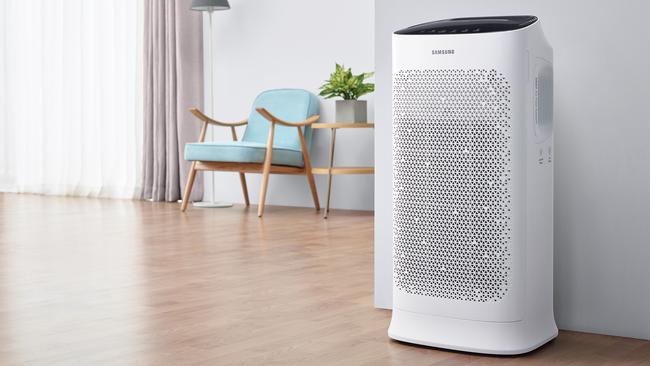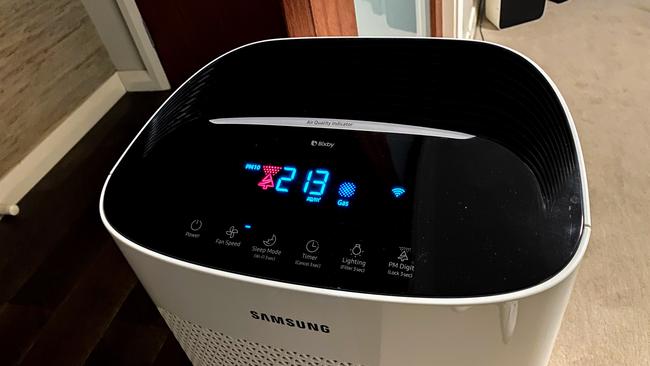Air purifiers — myth or magic? We look at the Samsung AX5500 to find out
To many, purchasing an air purifier for a home in this country sounds as logical as placing a dream catcher ornament in your bedroom.

Australia’s air quality is rated among the top ten globally. To many, purchasing an air purifier for a home in this country sounds as logical as placing a dream catcher ornament in your bedroom.
Despite this, there is a significant market for air purifiers in Australia which has not gone unnoticed by Samsung. The big Korean manufacturer has announced a new range of air purifiers so it was time to understand if and how they can benefit our lives.
Recent studies show that Australians are spending up to 90 per cent of our lives indoors. During lockdown that is likely even higher. The problem is that indoor air quality can be far worse than outdoors. With inadequate ventilation, pets, aerosols, dust, mould spores and other odours can all impact the quality of the air we breathe.
One area we can overlook is vacuuming. Adele Taylor, National Asthma Council’s Sensitive Choice program manager told The Australian that “It’s important to vacuum carpeted home offices often, but this can stir trapped particles up into the air, which the purifier would help to filter out.”
As we move towards spending more time working at home, air quality in the house becomes even more important.
Sotiris Vardoulakis, Professor of Global Environmental Health at the Australian National University (ANU), says: “certain groups may be particularly sensitive to the effects of air pollutants including young children, pregnant women, the elderly, and the one in nine Australians who suffer from respiratory health conditions such as asthma, hay fever or bronchitis”.

In a recent project with Dyson, who also make air purifying products, he mentioned how important it is for air purifiers to have a HEPA and active carbon filters. HEPA filters are often mentioned in the advertisements of airconditioning systems so we wondered if running our ducted or split systems could serve a similar purpose.
Gordon Sandor, manager at Original Safe T Air, works on retrofitting airconditioning units with air purification and filtration systems. He says some manufacturers of split system air conditioners say that they have HEPA filters installed that trap 99 per cent of germs. However, just lift the cover of the unit and look inside. There will be a multi-layer paper filter that covers maybe 10 per cent of the total filter area. Air is like water, so most of the air will flow around the HEPA filter, not through it.
Convinced that the science suggests air purifiers can improve the air quality in our homes, I unboxed the Samsung AX5500. A white unit that stands as high as a bar stool that sits on hidden wheels to make it easy to relocate in the home. Some assembly is required with the AX5500 but this is mainly the installation of serious layers of filters.
There’s a washable pre-filter designed to capture pollen, dust and pet dander (skin particles), an activated carbon deodorisation filter which captures gases and unpleasant odours and a HEPA filter which manufacturers claim can capture 99.97 per cent of ultra fine dust such as smoke, mould and exhaust fumes.
The top panel contains a large digital readout of the air quality in the home and has some control buttons. In Auto mode it’s a set and forget product that works to detect and clean the air. A sleep mode puts the product into a very quiet state which makes minimal noise. The AX5500 is internet connected through the Samsung Smart Things assistant. This lets you view the status of the device, and control and schedule the air purifier. I set it to run from 8am to 6pm during my home office working hours.

Air quality is displayed on a screen in micrograms. You’re wanting the lowest number possible. The AX5500 also uses lights to show air quality, if the numbers confuse you. Blue is great, red is very bad. I was glad that our air purifier lived in the blue zone during the day and would only jump into orange or red territory when aerosols were used such as antiperspirant or fly spray. This spray can usually linger in a room however the AX5500 worked harder once it was detected and removed it all in less than a minute.
Our local fire service used a weekend of perfect weather to perform back burning and we immediately understood why air purification products make sense. Waking up to the smell of a fireplace, which we don’t have, was very unpleasant. The nearby back burning smoke came through the home overnight.
Turning the Samsung AX5500 on with my smartphone sent the product into overdrive. Normally living in the blue zone with a score of 5, the air purifier quickly went to a red status with a score over 200. The noise is more like a small fan at this point but not overbearing. The AX5500 quickly did its job and brought our air quality back to a blue level.
This product pushes clean air out of three locations so that it circulates around your home. This can cause a breeze in the home office and on cooler days would make you colder. The Dyson Pure Hot+Cool can warm the air which would make it more pleasant in the winter months.
I don’t suffer from allergies and asthma, and I don’t have pets. Until now, I have regarded an air purifier as being for someone else. However we cannot always control external factors that impact air quality, so a purifier certainly has merit. Whether it is bush fires or your famous curry, you will immediately notice the difference the Samsung AX5500 can make. The rest is invisible, you just have to trust the science.
The Samsung Air Purifier Range starts from $449. The AX5500 has a recommended price of $799.
Geoff Quattromani is a tech commentator across radio, print, online and television. Check out his podcast “Technology Uncorked” for new information each week.



To join the conversation, please log in. Don't have an account? Register
Join the conversation, you are commenting as Logout